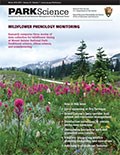
Cover Image: A subalpine hillside radiates magenta from mountain Indian paintbrush (Castilleja parviflora) during peak wildflower season at Mount Rainier National Park, Washington. Phenological studies are increasingly important for understanding the effects of climate change on wildflower timing and its implications for wildlife, visitors, and park operations. The case study listed below discusses trade-offs among three modes of gathering wildflower timing data. Credit: Janneke HilleRisLambers
This issue published
Online: 15 June 2017; In print: 15 June 2017
Departments
Features
Case Study
Research Reports
State of the Science
In Focus: Management of Grand Canyon's Popular Corridor Trail System
Last updated: January 20, 2025
